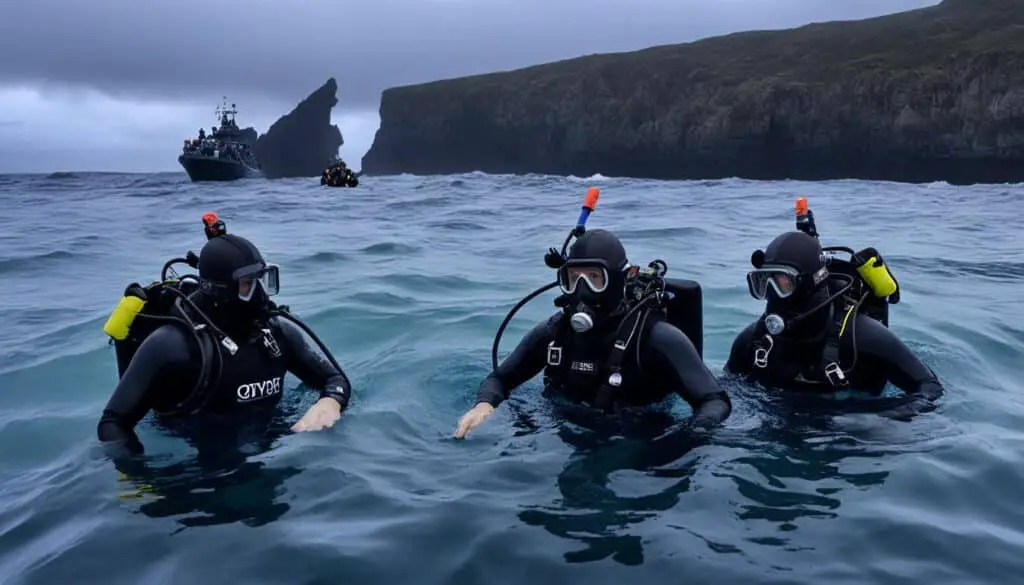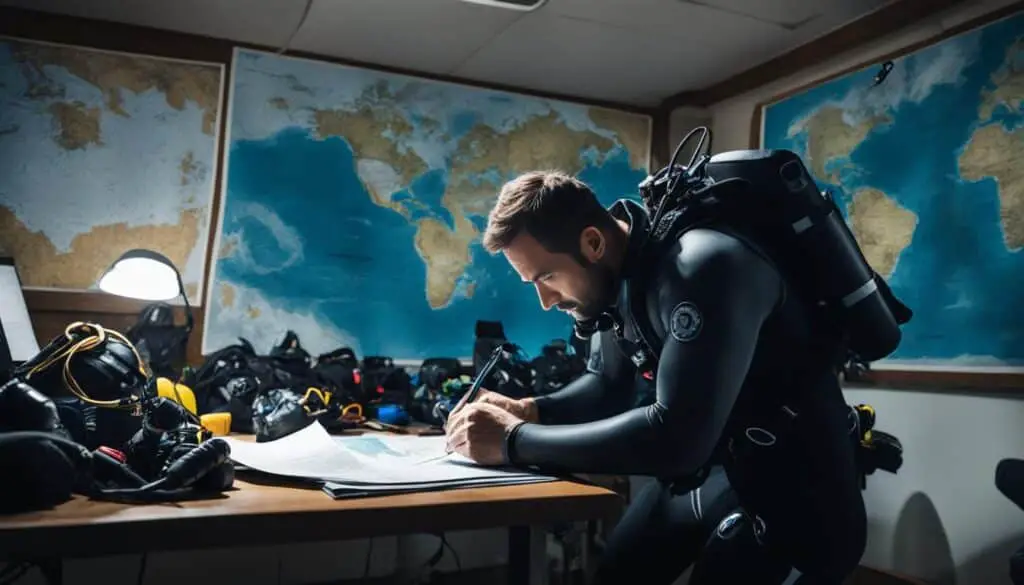When it comes to diving in extreme conditions, preparation is key. As an avid diver, I understand the importance of being well-equipped and knowledgeable when venturing into challenging environments. Whether you’re exploring cold waters, diving to great depths, or navigating strong currents, it’s crucial to have the right skills, gear, and mindset to ensure a safe and enjoyable experience.
In this article, I’ll share some valuable tips on handling extreme diving conditions. From understanding the risks and necessary equipment to training and planning, these insights will help you dive with confidence and make the most of each adventure.
Key Takeaways:
- Proper preparation is essential when diving in extreme conditions.
- Understanding the risks and potential dangers helps you stay safe underwater.
- Investing in high-quality diving equipment suitable for extreme conditions is crucial.
- Specialized training and certification provide the necessary skills and confidence to handle challenging situations.
- Thorough planning, research, and pre-dive checks contribute to a successful dive.
Understanding the Risks of Extreme Diving Conditions
Extreme diving conditions present unique hazards and dangers that divers must be aware of before taking the plunge. Whether you’re exploring deep depths, navigating strong currents, braving low visibility, coping with cold temperatures, or encountering unpredictable marine life, being knowledgeable about these risks is essential for a safe and enjoyable diving experience.
Strong currents: Powerful underwater currents can sweep divers off their intended path and potentially lead to dangerous situations. It is crucial to have the skills and knowledge to effectively manage and adapt to these currents.
Low visibility: Limited visibility can significantly impact orientation and navigation underwater. Divers must be prepared to rely on alternative methods, such as using dive lights or tactile navigation, to ensure they stay on track and avoid potential hazards.
Cold temperatures: Extreme diving conditions often involve colder waters, which can pose risks such as hypothermia or fatigue. Wearing appropriate exposure protection, such as drysuits or wetsuits, is crucial for maintaining body temperature and preventing heat loss.
Deep depths: Descending to significant depths brings about physiological changes and increased risks associated with decompression sickness and nitrogen narcosis. Divers must be trained and equipped to handle these deep dives safely and effectively.
Potential encounters with marine life: While encountering marine life is one of the joys of diving, it can also present risks. Awareness of the local marine ecosystem and understanding how to handle encounters with potentially dangerous species is vital for diver safety.
Being aware of the risks associated with extreme diving conditions allows divers to adequately prepare and take appropriate precautions, ensuring a safer and more thrilling underwater adventure.
Diving Dangers Infographic
| Risks | Dangers |
|---|---|
| Strong currents | Increased risk of disorientation, exhaustion, and separation from the dive group. |
| Low visibility | Potential for becoming lost, colliding with underwater structures, or encountering hazardous marine life without adequate visual warning. |
| Cold temperatures | Greater susceptibility to hypothermia, decreased manual dexterity, and fatigue. |
| Deep depths | Risk of decompression sickness, nitrogen narcosis, and challenges related to managing extended bottom times. |
| Potential encounters with marine life | Potential for accidental injury from marine life, such as stings, bites, or physical harm from large or aggressive species. |
Essential Equipment for Extreme Diving Conditions
When it comes to extreme diving conditions, having the right equipment is vital. In order to safely explore the depths of the underwater world, divers need gear that can withstand harsh conditions and provide optimal functionality. Here are some essential pieces of diving equipment that every diver should consider:
Drysuit or Wetsuit
For cold water diving, a drysuit or wetsuit is essential to protect against low temperatures and hypothermia. A drysuit offers full-body insulation and keeps the diver dry, while a wetsuit provides insulation through a layer of water between the suit and the skin. Both options are designed to maintain body heat and keep divers comfortable during long dives in cold water.
High-Quality Diving Mask
In low visibility conditions, a high-quality diving mask is crucial for maintaining clear vision and safety underwater. Look for masks with a wide field of view, comfortable fit, and a durable design. Anti-fog features, tempered glass lenses, and adjustable straps are also desirable features.
Dive Computer
When exploring deep depths, a dive computer is an essential tool for monitoring dive time, depth, and decompression limits. A reliable dive computer provides real-time data and helps divers plan and execute safe ascents. Look for models with clear displays, user-friendly interfaces, and robust safety features.
Dive Torch
In dark or low-light conditions, a dive torch is indispensable for illuminating the underwater environment and enhancing visibility. Choose a dive torch with a bright output, long-lasting battery life, and durable construction that can withstand the demands of extreme diving conditions.
Emergency Signaling Devices
In the event of an emergency, communication devices are vital for diver safety. Equip yourself with emergency signaling devices such as underwater signaling devices, dive location markers, and personal locator beacons. These devices allow divers to alert their dive buddies or signal for help if needed.
Investing in reliable and high-quality equipment is essential for the safety and success of any extreme diving expedition. The right gear can make all the difference in navigating challenging conditions and ensuring an unforgettable diving experience.
| Equipment | Features |
|---|---|
| Drysuit or Wetsuit | Full-body insulation and protection against low temperatures |
| High-Quality Diving Mask | Wide field of view, anti-fog features, and comfortable fit |
| Dive Computer | Real-time data, user-friendly interface, and safety features |
| Dive Torch | Bright output, long-lasting battery life, and durability |
| Emergency Signaling Devices | Underwater signaling devices, dive location markers, and personal locator beacons |
Training and Certification for Extreme Diving Conditions
Proper training and certification are essential for divers planning to explore extreme diving conditions. By undergoing specialized diving courses, divers can acquire the necessary skills and knowledge to handle the challenges that come with diving in extreme conditions.
- Advanced Open Water Diving: This course goes beyond the basic open water certification and equips divers with the confidence to navigate different environments and dive deeper depths.
- Deep Diving: This specialized course focuses on techniques, procedures, and safety protocols needed to dive to greater depths.
- Rescue Diving: Designed to enhance divers’ readiness in emergency situations, this course covers rescue techniques and teaches divers how to respond effectively to potential diving incidents.
- Ice Diving: For divers looking to explore cold-water environments, this course provides training on safety procedures and equipment specific to diving under ice.
It is crucial to choose reputable training organizations and experienced instructors to ensure a high level of competence and safety during extreme diving conditions.

Undergoing specialized training for extreme diving conditions equips divers with the necessary skills and knowledge to handle challenging situations underwater.
Planning and Preparation for Extreme Diving Conditions
Before embarking on an extreme diving adventure, thorough planning and preparation are crucial. To ensure a safe and successful dive, it is essential to take the following steps:
- Research the Dive Site: Gather information about the dive site, including water conditions, visibility, temperature, and potential hazards. This will help you understand what to expect and make necessary arrangements.
- Understand Local Conditions and Regulations: Familiarize yourself with local diving regulations, including any permits or certifications required. Additionally, learn about specific conditions such as currents, tides, and marine life encounters unique to the location.
- Create a Dive Plan: Develop a detailed dive plan that includes the dive site, depth, duration, emergency procedures, and buddy system. This plan will serve as a guide and ensure that you stay on track during the dive.
- Conduct Pre-Dive Checks: Before entering the water, perform thorough equipment checks. Inspect your diving gear, including the dive computer, buoyancy control device (BCD), regulator, and other essential equipment, to ensure everything is in proper working order.
- Assess Personal Fitness and Health: Extreme diving conditions can be physically demanding. It is crucial to evaluate your fitness level and overall health to determine if you are ready for the challenges. Consult with a medical professional if necessary.
- Have a Backup Plan and Safety Procedures: Prepare for unexpected situations by having a backup plan in place. Communicate with your dive buddy and establish emergency protocols to handle potential risks effectively.
Proper planning and preparation are essential for extreme diving. It not only ensures your safety but also enhances the overall diving experience. By taking the time to research, understand the conditions, create a dive plan, and conduct necessary checks, you can approach extreme dives with confidence and peace of mind.
| Planning and Preparation Guidelines for Extreme Diving |
|---|
| Research the dive site |
| Understand local conditions and regulations |
| Create a dive plan |
| Conduct pre-dive checks |
| Assess personal fitness and health |
| Have a backup plan and safety procedures |
By following these guidelines and being well-prepared, you can enjoy the exhilaration of extreme diving while ensuring your safety and maximizing the adventure.

Conclusion
Preparing for extreme diving conditions is key to diving with confidence and ensuring safety in challenging underwater environments. By acquiring the necessary knowledge, skills, and equipment, and implementing careful planning, divers can navigate extreme diving conditions with ease.
Understanding the risks associated with extreme diving conditions is paramount. Factors such as strong currents, low visibility, cold temperatures, deep depths, and encounters with marine life can pose significant challenges. By being aware of these risks, divers can take appropriate precautions and make informed decisions.
Proper training and certification are essential in preparing for extreme diving conditions. Specialized courses such as advanced open water diving, deep diving, and rescue diving provide divers with the necessary competence and confidence to handle challenging situations. Investing in reliable diving equipment, tailored to the specific conditions, is equally important.
Thorough planning and preparation play a vital role in ensuring a safe and successful dive in extreme conditions. This includes conducting site research, developing a dive plan, assessing personal fitness, and establishing safety procedures. By prioritizing safety and following established protocols, divers can dive prepared, confident, and ready to explore the wonders of the underwater world.
FAQ
What are some risks associated with extreme diving conditions?
Risks associated with extreme diving conditions include strong currents, low visibility, cold temperatures, deep depths, and potential encounters with marine life.
What equipment is essential for extreme diving conditions?
Essential equipment for extreme diving conditions may include a drysuit or wetsuit suitable for cold water diving, high-quality diving mask for low visibility, dive computer for deep dives, dive torch for dark conditions, and emergency signaling devices for communication and safety.
What kind of training and certification do I need for extreme diving conditions?
Specialized courses, such as advanced open water diving, deep diving, rescue diving, and ice diving, can provide divers with the necessary skills and knowledge to handle challenging situations in extreme diving conditions.
How should I plan and prepare for extreme diving conditions?
Planning and preparation for extreme diving conditions involve researching the dive site, understanding local conditions and regulations, creating a dive plan, conducting pre-dive checks, assessing personal fitness and health, and having backup plans and safety procedures in place.
